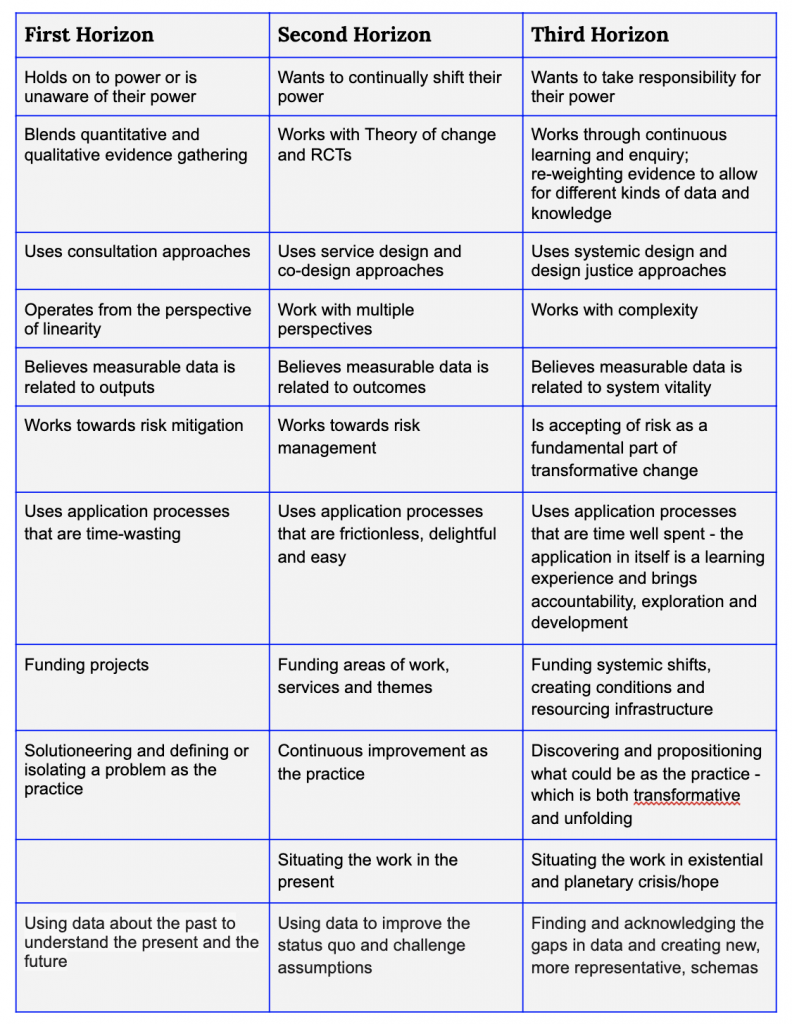I’ve been thinking a lot about grantmaking as a practice, and in particular what kinds of practices we need to steward what Arundhati Roy talks of here – ‘Another world is not only possible, she is on her way. On a quiet day, I can hear her breathing.’
Next week I’ll be publishing a set of resources that build on the blog post I wrote 18 months ago, and that are part of the materials I’m co-developing for a new creative grantmaking programme at Goldsmiths.
As a way of working out what different or new practices we might need in grantmaking I’ve found it helpful to use the 3 Horizons model, developed by Bill Sharpe.
Horizon 1 is ‘business as usual’. Within this first horizon, it’s hard not to see the pace of decline and the destructive consequences of continuing as we are: how our current economic models are damaging our environment and society; how rising inequality and insecurity are entrenching divides; how ceaseless consumption is threatening economic collapse. As the world changes, aspects of business as usual begin to feel out of place or no longer fit for purpose.
Horizon 3 is the future we dream of: a future where everyone can thrive; where we reward redistribution and contributing to the commons rather than growth; where we regenerate and care for each other and for the earth, not extract; and where we look after each other with justice and solidarity, not charity.
Between these horizons is Horizon 2 – the entrepreneurial horizon where a pattern of transition activities and innovations are tried out in response to the ways in which the landscape is changing. Lots of current energy and investment in innovation sits in this second horizon, with new practices, ventures and technologies that could either extend the status quo or act as steps towards a different and more transformative future. For example, we can use new tools to consume faster, cheaper versions of things we are used to (like Uber creating a new business model for private urban transport) or find ways to challenge the norms and create new paths forward.
My ambition for grantmaking practice is that we use our practice and resources to be field-builders for the third horizon and seek to partner in long-term change. The table below is my first attempt at trying to plot out and make some distinction about the evolution of grantmaking practices that we need.
A few caveats to bear in mind first.
- This is an initial draft – and I am still very much in a discovery place with it. I’m publishing this to welcome feedback, input and critique.
- It can be crude to split things up in a table. I recognise that there is not always such distinction between things and that I’m being simplistic or reductive in some places.
- I know that some people will be practicing all three. And in some cases we need all three – like row 5!
- I’m not suggesting the third column is superior, I am just trying to draw out what might be most distinctive in the new practices I think we need in grantmaking if we are to field build towards the third horizon.
- These are written from the perspective of a grantmaker — drawing out the mindset, behaviours or practice you might expect to see.


I’d love to know what people think and it’s open for comments here.
Cassie Robinson is the Deputy Director of Funding Strategy at The National Lottery Community Fund.
Thank you to my brilliant philanthropy peer circle convened by Brian Stout and from whom I’m lucky to learn with — Motaz Attalla, Mandy Van Deven, Michelle O’Grady Caballer, Christina Antonakos-Wallace, Lindley Mease, Melanie Brown, John Gautam, Ada Williams Prince, Jennifer Hoos Rothberg, Bridgit Antoinette Evans and to Sophia Parker, Rachel Coldicutt, Cat Drew, Jennie Winhall and Laura Bunt who contributed and edited.



Comments (1)